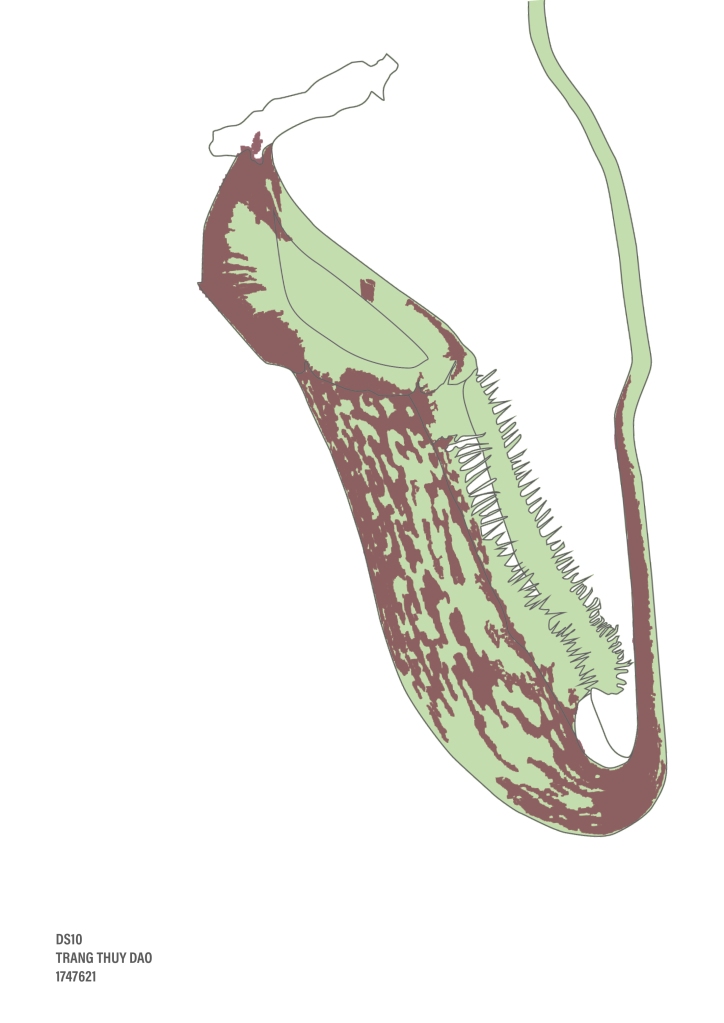



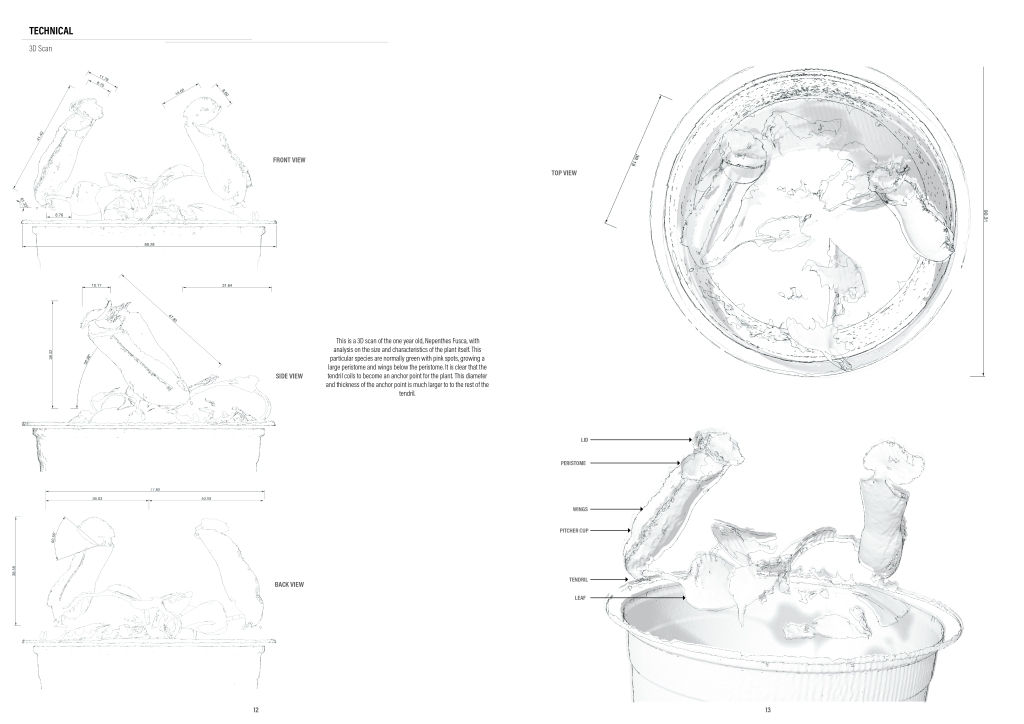

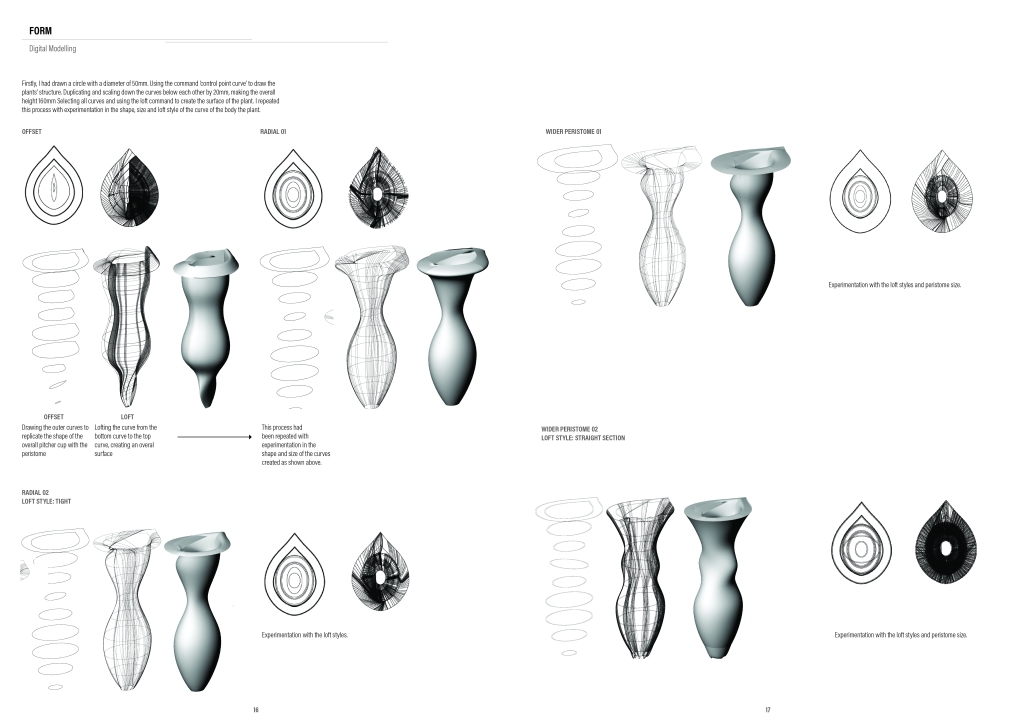

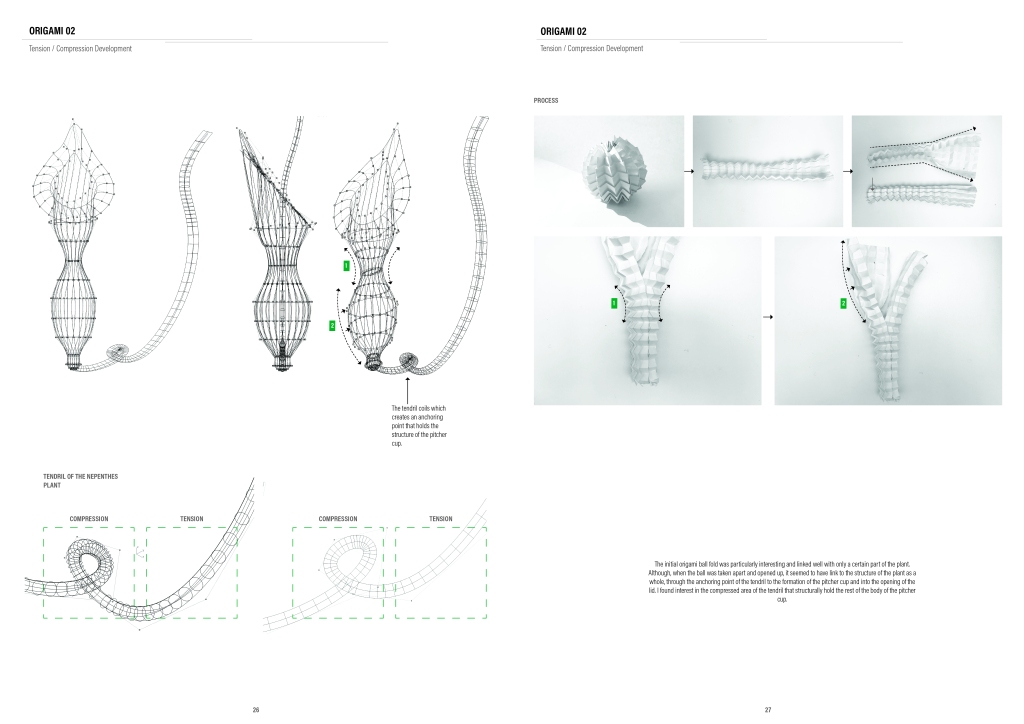





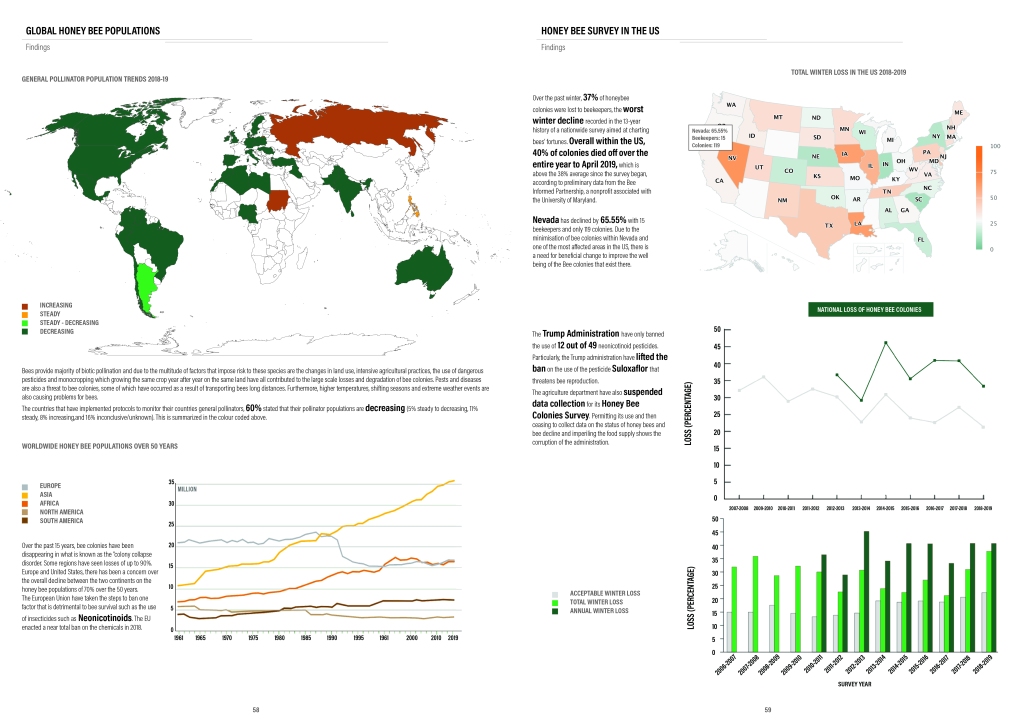
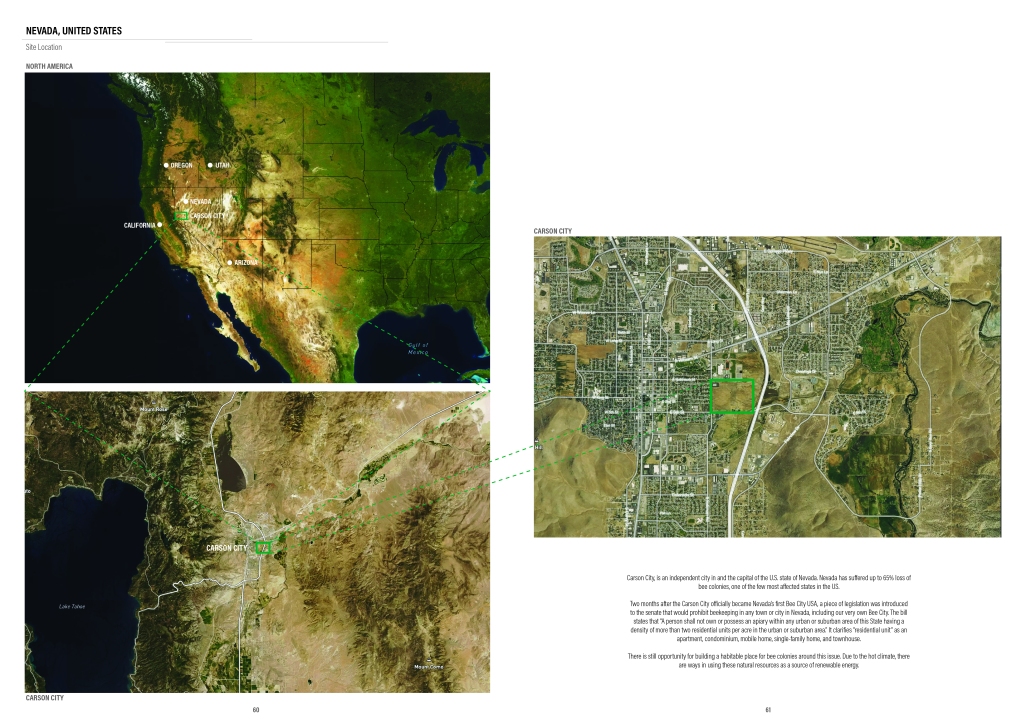
















The Fractal Hourglass counts down to the singularity, the moment that artificial super-intelligence triggers an unprecedented shift in human civilisation. The concept of recursively self-improved AI is portrayed by a tower of iterated fractal trusses, in which time is measured by a cascade of light.
Triangular steel trusses array to form a 15-foot tall hourglass silhouette, where scaled repetitions within each truss form a lattice of increasing complexity and infinite bounds. The visual density of each truss intensifies at each fractal iteration, culminating in the filling of the lower hourglass bulb, representing the finite time remaining until the singularity. At night, a dynamic cascade of LEDs will flow on and off from the upper to the lower bulb, a spectacle alluding to sand pouring through an hourglass.

The steel tubes forming the piece range from a diameter of 1.5″ in lengths from 1 to 3-feet, which are hammered flat and bolted to form the main structure, and 0.5″ diameter tubes welded inside to form the decorative fractal repetitions.

On approach, the tense drama of time running out is visible through the concentration of material in the bottom of the hourglass, provoking an instinct to stall the process. Burners have a choice of how to experience the hourglass- whether that is to ascend the structure to experience the inversion of the hourglass as the bulb empties, where ascension serves as a sanctuary from the saturation of technology and AI in the lower bulb. Or they can recline on the ground and let their eyes weave through the layers of trusses and bathe in the saturation and complexity of technological advancement. Or simply to turn away and let what effectively has become a natural process to take its course. At night, the cascading light display forms an even more immersive encounter with the hourglass, as waves of light repeat the process of time as it funnels through and fills the lower bulb, swarming anyone who is inside.
The finite nature of fractals in the hourglass represents the capacity for infinite artificial intelligence- each increment provides an equally stable steel structure, whilst having the capacity to use less and less material, but only to a point. It is not possible for this fractal to reach infinity and be constructed at a human scale. This poses the question of, at which point on the way to infinity do humans get before their intelligence can be overtaken by AI- the moment of the singularity. Is it too late to invert the hourglass and, given the choice, would you want to?
The Fractal Hourglass allows for Burners to take a moment to relish on their existence as humans, with the capacity to orchestrate their own experience, something which AI’s currently don’t possess. Artificial intelligence is currently an opportunity to shape a future experience where humans can outsource themselves, freeing up valuable time and energy. The hourglass serves as a visual symbol that human existence is fleeting so long as AI is permeating our lives, and provides a timer for the impending singularity, a moment that will transform the world as we know it, a reminder that we still have the alluring capacity to define and create.
‘The first ultra-intelligent machine is the last invention that man need ever make, provided that the machine is docile enough to tell us how to keep it under control.’
I J Good
As the Maker World develops, we want to have a greater impact on our environment, the spaces we live in. Auxetic Assemble gives you a chance to build your own furniture and have a input in your product. Auxetic Assemble gives you the chance to buy either the cut parts for the product or the instructions and CNC cutting files to then source your own material, cut your own product and assemble your work. The future of this adaptable design system allows the product to be fitted and designed to your require space.
The Pavilion
I have set up a Kickstarter Campaign in order to Fund a Pavilion in Hackney. The Pavilion is the next step in the journey to developing this system to its future potential. The construction process used for the plywood shelves will be developed at the larger scale to develop a pavilion to display the process of constructing the shelves and to exhibit the product. The Pavilion walls will become the seating, shelving and tables for the space. This is a chance to explore the system at a larger scale in order for further development for future of housing, an adaptable system that can be applied to a unique space and engages everyone as its workforce to build it.
The Products
The design system has been developed into shelving product to sell as rewards, both in cardboard and plywood.
Follow the links to the Kickstarter Page to help this project be realized, Click on any image for the Kickstarter page link. Thank you.
My initial studies stemmed from researching into Stellation. This, in simple terms, is the process of extending polygon in two dimensions, polyhedron in three dimensions, or, in general, a polytope in n dimensions, to form a new figure. Through researching the application of this process, I came across the sculptures created by George Hart, as he has experimented with stellated geometries to which are subdivided to create mathematical interweaving structures.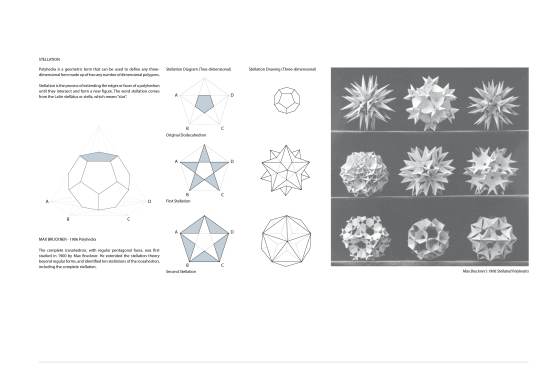
My Research into the method and calculations of George Hart’s Mathematical Sculpture’s focused on the sculpture ‘Frabjous’. Through rigorous testing and model making I have understood the rules behind the complex form. This is based on the form of a stellated icosahedron, whose shape is contained within a dodecahedron.
Lines are drawn from one point, to a point mirrored at one edge of the face of the dodecahedron form – as shown in the diagram. This creates intersecting lines at each face as you can see from the diagrams below. Each dividing line has two intersection points, with symmetry at the center of the line. The sculpture aims to avoid the intersections of these lines by introducing a sine curve with the domain 0 to 2*pi. As you can see, each component is exactly the same – for this model, 30 components are used.
`To simplify the construction of the sculpture, I extracted a build-able section which uses ten components in total. Two of these sections are then weaved together and joined up by a further ten single components to form the entire sculpture.


Following this research, I extracted the concept of avoiding the intersection and subdivided a cube with lines from each corner of the cube. These lines were then weaved around eachother using a sine curve with a domain of 0 to pi. I then mirrored the curves and rotated them to create an intertwining form.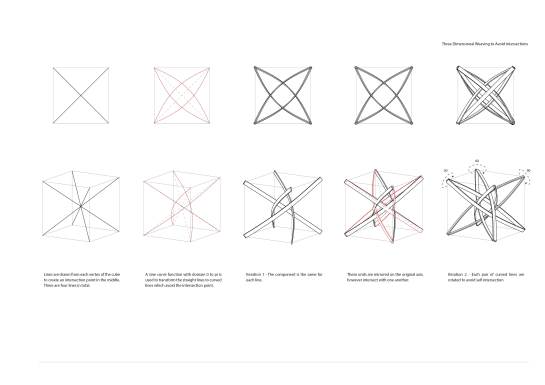
Another test was created with the same process, however subdividing a cube using the midpoint of each face. – This creates an octahedral geometry.
Using this interweaving geometry, I have created different three dimensional arrays to create a spatial form. The concept of avoiding intersections naturally cause a structure to fail. To form a structurally efficient version of this geometry, I introduced the idea of a reciprocal structure, and allowed the beams to self support by resting on eachother. This did not create a structure strong enough to stand on, however through adding a cube whose dimensions are equal to the width of the beams, the structure became very strong.
Testing the component at a small scale required the design of a joint which allowed me to assemble these components together through interlocking elements. Each beam element slots into the joint; When two joints and two beams are connected together the curves naturally stay in place due to the angle cut into the joint. Three of these connected elements together form the component.
As mentioned previously, avoiding intersections create inefficient structures – For this small scale experimentation, the concept of Tensegrity was implemented. Tensegrity is a structural principle based on using isolated compression components within a net of continuous tension, allowing the compression members to not need to touch each other. This model was constructed using 1.5mm plywood which has been laser cut; the modularity of the system ensures minimal material wastage.
The three dimensional array of this geometry creates many interesting shapes and patterns when viewed from different angles – this is visible in the following video:
Some images of our final cross-crit of the year! Our students presented their Brief03:FutureCities. Have a look at how the next generation of architects envision the future of our cities.
Thank you to Andrei Jipa, Kester Rattenbury and Lindsay Bremner. Final sprint to the portfolio submission and end of year!




The Atlantic Forest in southern Brazil has long been viewed as a vast quilt of rain forest interspersed by small river outposts. The surging population growth has seen these remote settlements transform this ancient rural vision to an expansive city scale. Cidade de Árvores (City of Trees) envisions an environment where both the city’s infrastructure and its inhabitants maintain a symbiotic relationship with the surrounding natural environment. Built entirely from locally grown timber, the Cidade de Árvores exists as a network of steam bent beams, joined to form a structural space frame. Like the forest, the frame is allowed to grow and develop organically over time with inhabitants adding to structure to meet their requirements. The city is powered through the use of micro wind turbine electricity generation which manifests as a series of towers scattered throughout the forest. For the city and the environment to function in harmony, the city access routes manifest as elevated walkways around large courtyards, allowing light to penetrate to the forest floor.







WeWantToLearn.net has a live Kickstarter Campaign. Please help us bring to life three beautiful students projects for this year’s Burning Man festival and receive some exciting rewards such as the T-Shirts shown below with the three digital designs: http://kck.st/1ESCVFb

It is the end of the second term for the University of Westminster and what a term for DS10! Four projects almost completed at BuroHappold’s engineering headquarters, Three projects to build at the Burning Man festival this summer. We could not be more happy and proud of our students… And it is not finished: after having produced a timeline of the scientific discovery and science-fictional predictions, they have started designing a future city (Brief03) based on their Brief01 and Brief02 work. Here are some pictures showing the students and their current research. Happy Easter everyone!





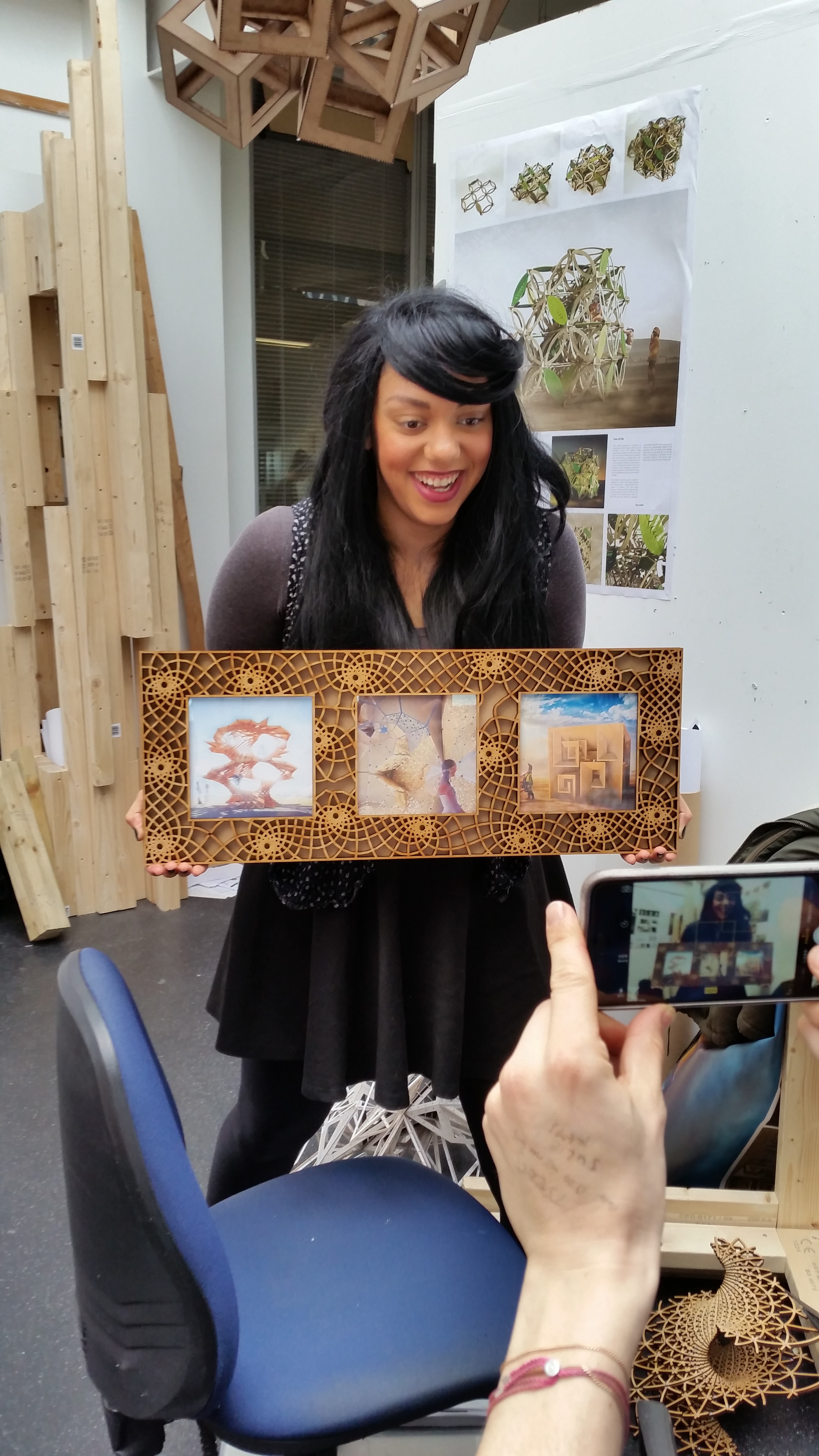





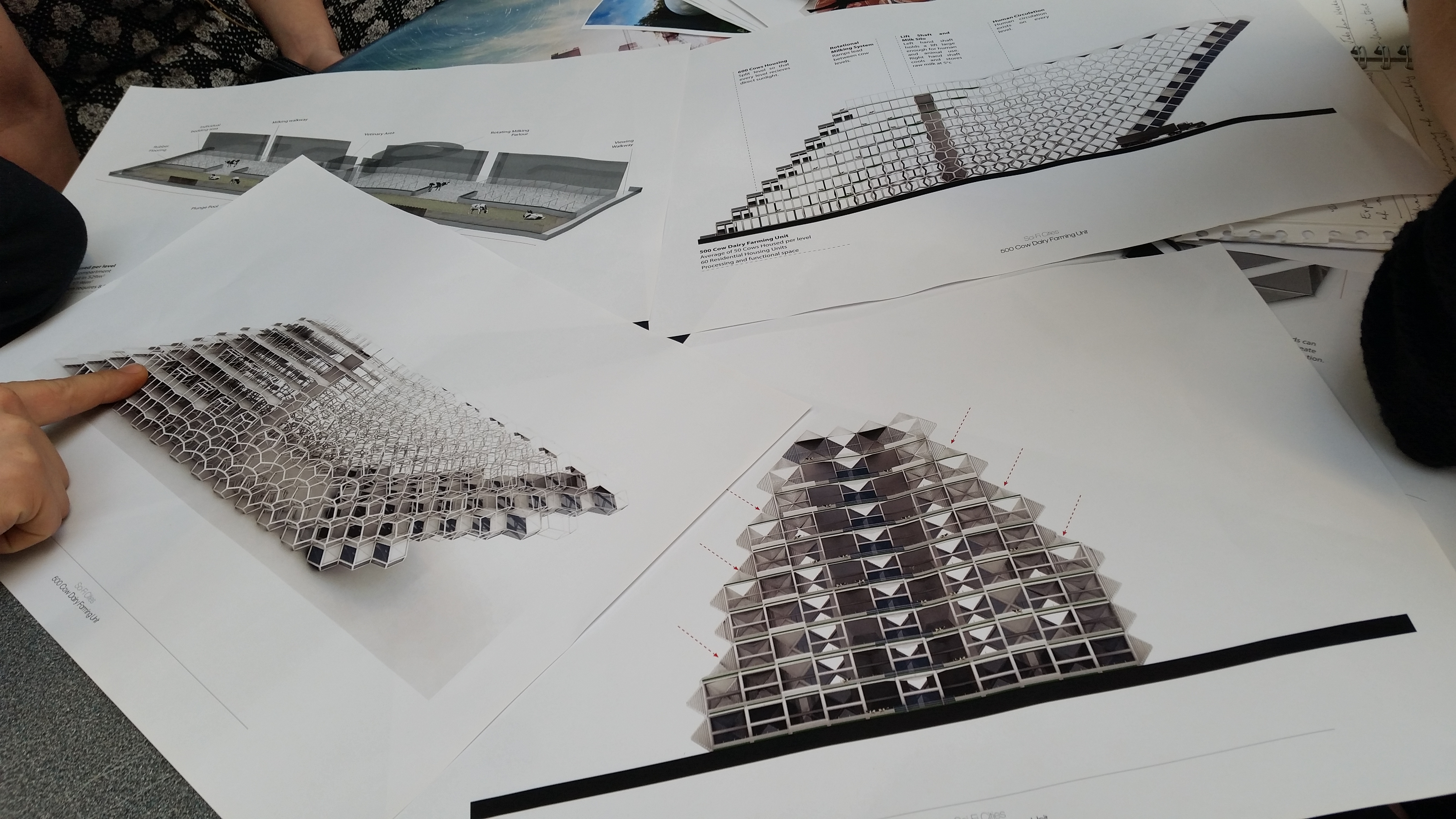




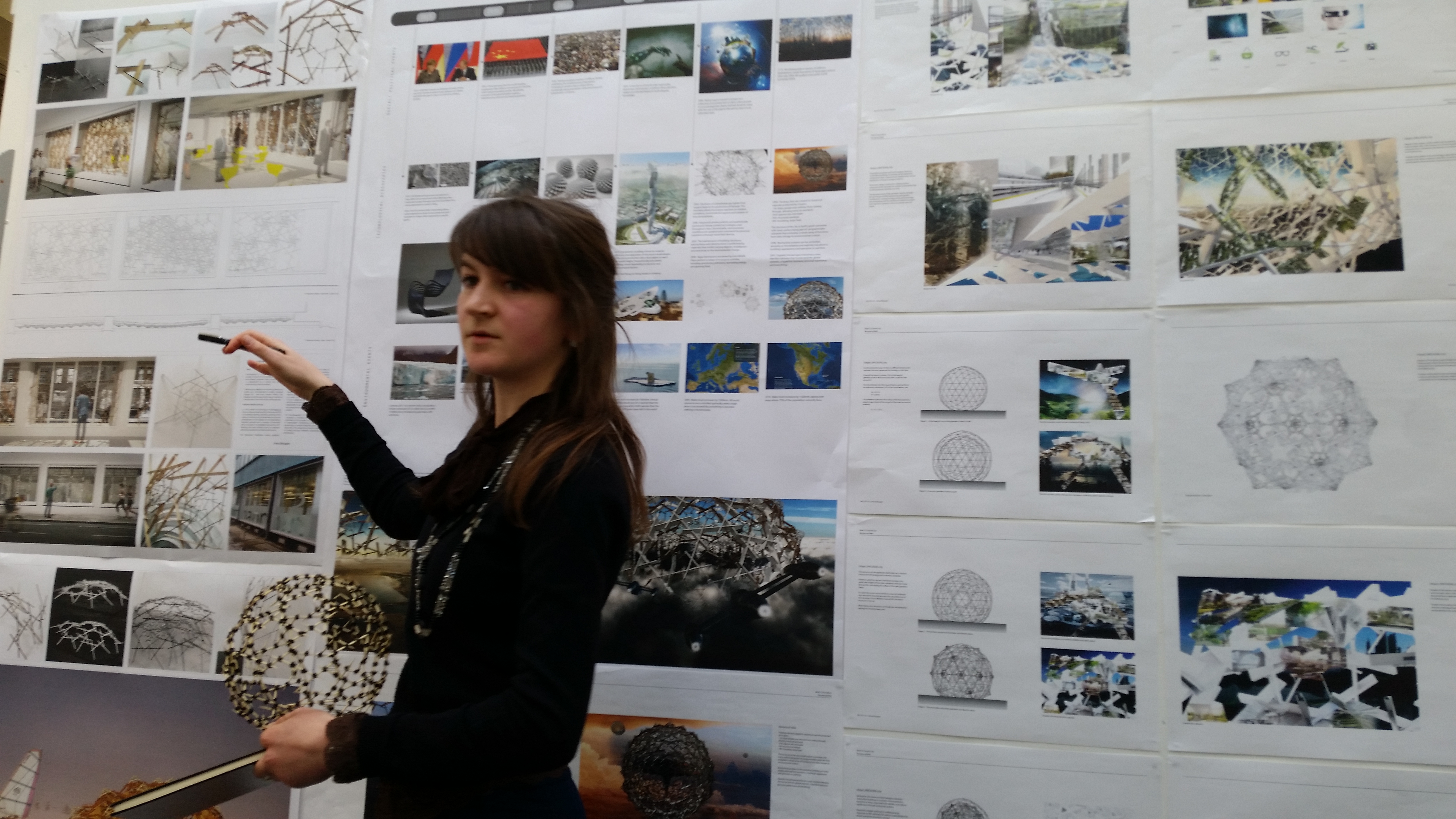


‘Infinite Territory’ invites burners from the surrounding playa to it’s periphery; its simple mirrored cubic exterior reflects the picturesque landscapes, unpredictable weather and inspirational artworks, creating an experience of both the real and the reflected whilst encouraging unexpected discoveries throughout the journey of the Burning Man Festival. At night, the cube will reflect the vibrancy of the playa. Illuminated strips of colourful light will glow at each edge to allow for clear visibility and frame the vistas; encouraging physical exploration within the structure and providing an immersive experience that juxtaposes the setting of the desert, and in doing so, offers a place for discovery; to recognise our inner selves and the reality of those around us.
The real gem of the ‘Infinite Territory’ is revealed from within – the burner will climb into a boundless space of infinite reflections that will hypnotise and bewilder, whilst creating a place for contemplation and speculation. Illuminated patterns will flicker and grow through key-frames of acrylic. Within this immersive digital dimension will be soft items providing a refuge from the elements. The installation will be made up of mirrored panels at each face of the cube. Three of these faces will consist of panels built with five layers of transparent perspex – each panel consists of a different pattern and when light is moved from one to the other it creates a dynamic lighting animation.
The primary structure of ‘Infinite Territory’ will be a timber framed cube using three meter length beams. The lateral stability will be reinforced using rigid panels of mirror and acrylic that shall form the artwork for the internal visual of the cube. The frame and the perspex/mirrored panels will be joined together (including any internal lighting effects) with metal brackets to reinforce the structure. This will help the overall mass resist wind loads and the harsh weather conditions of the Nevada Desert. The installation will consist of off-site fabrication of each panel leaving on-site construction reduced to the assembly of it’s component parts.
‘Infinite Territory’ will leave no trace wherever it goes; using a sheet size of 1.5m x 3m, the components of the installation allow for easy construction and deconstruction. Its weight and self-supporting robust construction means that no foundations are needed and the playa is left untouched beneath its surface.
The lighting will feature a pre-sequenced animation of LED strip lights that will illuminate the patterns giving the effect that is shown in the conceptual visuals. The lighting will be located at two opposite edges of each acrylic panel, and its components will be visually hidden within the structure. Externally, colourful electroluminescent wire at each edge of the cube will allow for clear visibility of the mirrored surface whilst framing the vistas.

Reflection presents this years burners with an intimate setting in which to share their inner most confessions, secrets and tales – With the option to do so both openly with other burners face to face, or retain the mystery of their identity by sharing with a complete stranger through the pavilions semi private screen. Reflection embodies the theme ‘Carnival of Mirrors’ in a variety of manners:- the geometry of the pavilion not only mirrors itself in its own form, but also incorporates a reflective surface within its interior spaces. The reflective physicality of the pavilion beautifully juxtaposes its function, by giving its burners a physical platform with which to cogitate their innermost thoughts and feelings, and share these with others. The pavilion is created as a result of rigorous testing of origami in order to create a single Spiralhedron which is then mirrored through along all axis.


Based upon a geometric origami principle which outlines the rules for the triangular subdivision of a 2-dimensional shape and assigns mountain and valleys creases to each subsequent subdivision the Spiralhedron has been optimised through both digital and physical testing. Reflection takes an abstract approach to this years theme, the pavilion’s form manifests itself as a result of mirroring this singular Spiralhedron in the X,Y and Z axis, which in turn creates its enclosing plywood form. In order to create the semi-private confessional screen, the panels incorporate a pattern, providing both the function of privacy, but also narrating the origins of the pavilions final form.
The principles of Burning Man are carefully considered, by providing an interactive base for participation that is never fully accomplished without the burners involvement. By sharing their stories, burners create a unique experience manifested through the ideals of trust and sharing, which facilitates a special bond between the burners. Upon its burning at the end of the festival, ‘Reflection’ becomes a resting place for the confessions, secrets and stories of its burners, allowing new bonds to be formed.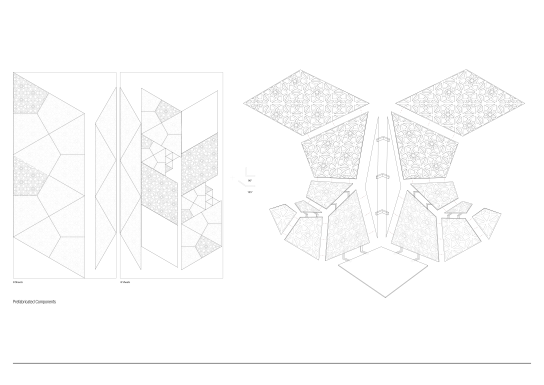

Construction
Due to form being created through the act of mirroring the entire pavilion will be made of 9 unique laser cut panels which will be bolted together with both metal hinges and 90 degrees and wooden brackets at 135 degrees.
Dimensions
Constrained by the size of a plywood sheet each individual Spiralhedron is made of two sheets of plywood (requiring 16 in total). Made of eight spiralhedrons ‘Reflection’ has a footprint of 3.5metres*3.5metres with a maximum height of 3.5m creating a footprint equal to that of the height of the pavilion.
Here we are – we have reached the middle of the academic year at the University of Westminster. Time to assess and appreciate our students portfolios and hard work during a lively “interim cross-marking” with our colleagues. Here are couple examples of the most remarkable portfolios in our Diploma Studio 10. Very excited to start our new brief03 on future cities. We will soon announce the three winners in our studio which will get the opportunity to build installations at the new headquarters of Buro Happold and students will soon post their Burning Man proposals on this blog. Oh and we are also going to our unit trip to Copenhagen next week!! Pictures by Toby Burgess.





